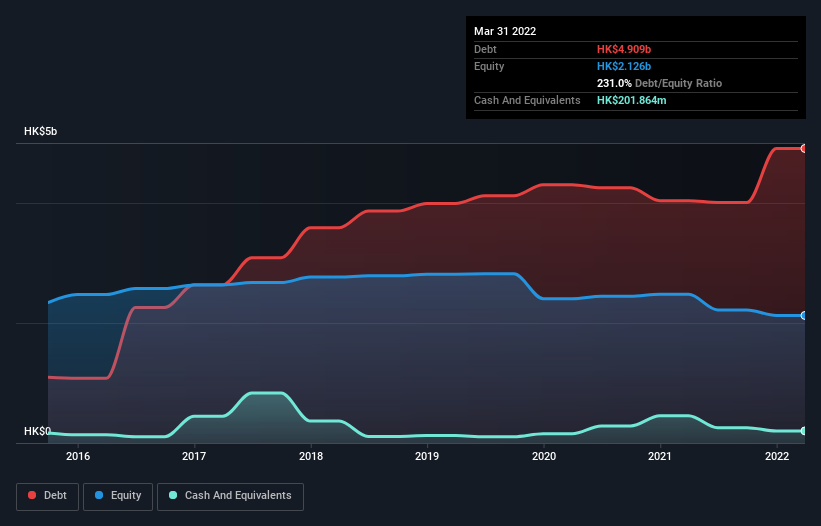- Hong Kong
- /
- Construction
- /
- SEHK:1271
Does Grand Ming Group Holdings (HKG:1271) Have A Healthy Balance Sheet?

Warren Buffett famously said, 'Volatility is far from synonymous with risk.' So it might be obvious that you need to consider debt, when you think about how risky any given stock is, because too much debt can sink a company. We can see that Grand Ming Group Holdings Limited (HKG:1271) does use debt in its business. But the real question is whether this debt is making the company risky.
When Is Debt A Problem?
Debt is a tool to help businesses grow, but if a business is incapable of paying off its lenders, then it exists at their mercy. Part and parcel of capitalism is the process of 'creative destruction' where failed businesses are mercilessly liquidated by their bankers. While that is not too common, we often do see indebted companies permanently diluting shareholders because lenders force them to raise capital at a distressed price. Of course, plenty of companies use debt to fund growth, without any negative consequences. The first thing to do when considering how much debt a business uses is to look at its cash and debt together.
See our latest analysis for Grand Ming Group Holdings
What Is Grand Ming Group Holdings's Net Debt?
You can click the graphic below for the historical numbers, but it shows that as of March 2022 Grand Ming Group Holdings had HK$4.91b of debt, an increase on HK$4.04b, over one year. However, it does have HK$201.9m in cash offsetting this, leading to net debt of about HK$4.71b.

A Look At Grand Ming Group Holdings' Liabilities
Zooming in on the latest balance sheet data, we can see that Grand Ming Group Holdings had liabilities of HK$8.49b due within 12 months and liabilities of HK$61.8m due beyond that. Offsetting these obligations, it had cash of HK$201.9m as well as receivables valued at HK$299.0m due within 12 months. So its liabilities total HK$8.05b more than the combination of its cash and short-term receivables.
Given this deficit is actually higher than the company's market capitalization of HK$7.74b, we think shareholders really should watch Grand Ming Group Holdings's debt levels, like a parent watching their child ride a bike for the first time. Hypothetically, extremely heavy dilution would be required if the company were forced to pay down its liabilities by raising capital at the current share price. When analysing debt levels, the balance sheet is the obvious place to start. But you can't view debt in total isolation; since Grand Ming Group Holdings will need earnings to service that debt. So when considering debt, it's definitely worth looking at the earnings trend. Click here for an interactive snapshot.
Over 12 months, Grand Ming Group Holdings made a loss at the EBIT level, and saw its revenue drop to HK$818m, which is a fall of 45%. That makes us nervous, to say the least.
Caveat Emptor
Not only did Grand Ming Group Holdings's revenue slip over the last twelve months, but it also produced negative earnings before interest and tax (EBIT). Indeed, it lost HK$13m at the EBIT level. When we look at that alongside the significant liabilities, we're not particularly confident about the company. It would need to improve its operations quickly for us to be interested in it. Not least because it had negative free cash flow of HK$21m over the last twelve months. So suffice it to say we consider the stock to be risky. When analysing debt levels, the balance sheet is the obvious place to start. But ultimately, every company can contain risks that exist outside of the balance sheet. Case in point: We've spotted 5 warning signs for Grand Ming Group Holdings you should be aware of, and 3 of them shouldn't be ignored.
Of course, if you're the type of investor who prefers buying stocks without the burden of debt, then don't hesitate to discover our exclusive list of net cash growth stocks, today.
New: Manage All Your Stock Portfolios in One Place
We've created the ultimate portfolio companion for stock investors, and it's free.
• Connect an unlimited number of Portfolios and see your total in one currency
• Be alerted to new Warning Signs or Risks via email or mobile
• Track the Fair Value of your stocks
Have feedback on this article? Concerned about the content? Get in touch with us directly. Alternatively, email editorial-team (at) simplywallst.com.
This article by Simply Wall St is general in nature. We provide commentary based on historical data and analyst forecasts only using an unbiased methodology and our articles are not intended to be financial advice. It does not constitute a recommendation to buy or sell any stock, and does not take account of your objectives, or your financial situation. We aim to bring you long-term focused analysis driven by fundamental data. Note that our analysis may not factor in the latest price-sensitive company announcements or qualitative material. Simply Wall St has no position in any stocks mentioned.
About SEHK:1271
Grand Ming Group Holdings
An investment holding company, engages in the building construction, property leasing, and property development businesses in Hong Kong.
Questionable track record very low.
Market Insights
Community Narratives




